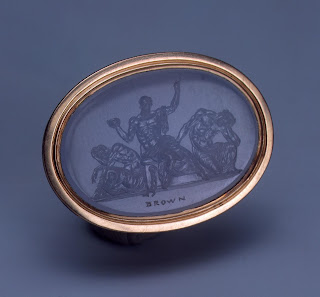 |
| Charles and William Brown Cameo Venus Anadyomene ca. 1770-1800 jasper Victoria & Albert Museum, London |
"This tiny work, signed ‘Brown’, is beautifully cut from three strata of jasper. The dark green top layer has been partially removed to reveal the figure of Venus carved into the whitish middle layer, outlined against the dark green base. Traces of green have been retained to color the hair of Venus, the dolphin and the waves."
"The art of engraving gemstones can be traced back to ancient Greece in the 8th century BC and earlier. Techniques passed down to the Egyptians and then to the Romans. There were major revivals of interest in engraved gems in Europe during the Byzantine era, the Middle Ages, the Renaissance, and again in the 18th and 19th centuries. At each stage cameos and intaglios, these skillful carvings on a minute scale, were much prized and collected, sometimes as symbols of power mounted in jeweled settings, sometimes as small objects for private devotion or enjoyment. This cameo is signed 'Brown', which means it was made by one or other, or both, of the engravers William and Charles Brown. Scant details are available of the early background or training for the brothers William (b. 1748; d. London 1825) and Charles (b. 1749; d. 1795) Brown. From 1766 until 1770 William exhibited at the Society of Arts, and from 1770 to 1785 both brothers exhibited annually at the Royal Academy. William was the more prolific of the two, producing gems with classical themes, and contemporary portraits; Charles showed fewer gems and favored animal subjects. From 1786 until the death of Charles in 1795 the brothers ceased to exhibit, as the first of numerous commissions for their work were received from the court of Catherine II, Empress of Russia. Ultimately perhaps half of their total output - 200 cameos and intaglios - were sent from the Brown’s London workshop to this great collection, and these remain together in the Hermitage, St Petersburg."
– curator's notes, Victoria & Albert Museum
Below, some of the gems sent to Saint Petersburg by the Browns for the collection of Catherine the Great –
 |
| Charles and William Brown Intaglio Prosperity and Love of Peace of Catherine II 1790 citrine Hermitage, Saint Petersburg |
 |
| Charles and William Brown Cameo Catherine II instructing her Grandsons 1789-91 agate Hermitage, Saint Petersburg |
 |
| Charles and William Brown Cameo Allegory of Russia's victory over Turkey 1790-91 agate Hermitage, Saint Petersburg |
 |
| Charles Brown Cameo Allegory of Russia's victory over the Turkish fleet 1790 agate Hermitage, Saint Petersburg |
 |
| William Brown Intaglio Monument to Peter the Great by Etienne-Maurice Falconet ca. 1782 rock crystal Hermitage, Saint Petersburg |
 |
| Charles and William Brown Cameo Catherine II crowning Prince Potemkin with laurels 1790 sardonyx Hermitage, Saint Petersburg |
 |
| Charles and William Brown Cameo Memorial on the death of Prince Potemkin 1791-92 onyx Hermitage, Saint Petersburg |
 |
| Charles and William Brown Intaglio Allegory of Marriage 1793 carnelian Hermitage, Saint Petersburg |
 |
| Charles and William Brown Intaglio Death of Socrates ca. 1791 chalcedony Hermitage, Saint Petersburg |
 |
| William Brown Intaglio Caius Martius Coriolanus at Minturna ca. 1796 carnelian Hermitage, Saint Petersburg |
 |
| William Brown Intaglio Abduction of Europa ca. 1783 carnelian Hermitage, Saint Petersburg |
 |
| Charles Brown Intaglio Mars and Bellona ca. 1784 carnelian Hermitage, Saint Petersburg |
 |
| Trade-card Willm. & Chas. Brown, Seal Engravers, Pall Mall 1781 British Museum |